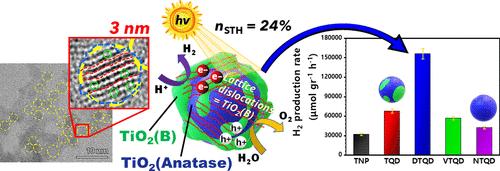当前位置:
X-MOL 学术
›
ACS Catal.
›
论文详情
Our official English website, www.x-mol.net, welcomes your
feedback! (Note: you will need to create a separate account there.)
{TiO2/TiO2(B)} Quantum Dot Hybrids: A Comprehensible Route toward High-Performance [>0.1 mol gr–1 h–1] Photocatalytic H2 Production from H2O
ACS Catalysis ( IF 11.3 ) Pub Date : 2024-11-20 , DOI: 10.1021/acscatal.4c05001 Christos Dimitriou, Loukas Belles, Nikos Boukos, Yiannis Deligiannakis
ACS Catalysis ( IF 11.3 ) Pub Date : 2024-11-20 , DOI: 10.1021/acscatal.4c05001 Christos Dimitriou, Loukas Belles, Nikos Boukos, Yiannis Deligiannakis

|
Industrial-scale photocatalytic H2 production from H2O is a forward-looking aim in research and technology. To this end, understanding the key properties of TiO2 as a reference H2 production photocatalyst paves the way. Herein, we explore the TiO2 nanosize limits, in conjunction with the TiO2(B) nanophase, as a strategy to enhance the photocatalytic H2 production at >150 mmol/g/h. We present a targeted engineering realm on the synthesis of quantum dots (QDs) of TiO2 consisting of an anatase core (3 nm) interfaced with a nanometric shell of the TiO2(B) phase, synthesized through a modified flame spray pyrolysis (FSP) process. The {TiO2-anatase/TiO2(B)} core–shell QDs, with high specific surface area SSA = 360 m2/gr, achieve a milestone H2 production yield of 156 mmol/g/h and solar-to-H2 efficiency nSTH = 24.2%. We demonstrate that diligent control of the TiO2-anatase/TiO2(B) heterojunction, in tandem with lattice microstrain, are key factors that contribute to the superior H2 production, i.e., not only the high SSA of the QDs. At these quantum-size limits, the formation of lattice dislocations and interstitial Ti centers enhances photon absorption at ∼2.3 eV (540 nm), resulting in the generation of midgap states around the Fermi energy. EPR spectroscopy provides direct evidence that the photoinduced holes are preferentially localized on the TiO2(B) shell, while the photoinduced electrons accumulate on the anatase nanophase. Combined electrochemical and photocatalytic analyses demonstrate that the presence of an optimal TiO2(B) phase is significant for the photoactivity of TiO2 in all QD materials. High SSA does contribute to enhanced photocatalytic H2 production; however, its role is not the key-determinant. TiO2 lattice-dislocations in QDs provide extra DOS that can additionally assist in the photon utilization efficiency. Overall, the present work reveals a general concept, that is, at the quantum-size scale, lattice microstrain engineering and interstitial-states' formation are spontaneously facilitated by nanolattice physics. Diligent optimization of these properties offers a pathway toward high-end photocatalytic efficacy.
中文翻译:

{二氧化钛/二氧化钛(B)}量子点杂化物:从 H2O 实现高性能 [>0.1 mol gr–1 h–1] 光催化生产 H2 的可理解路线
从 H2O 生产工业规模的光催化 H2 是研究和技术的前瞻性目标。为此,了解 TiO2 作为参考 H2 生产光催化剂的关键特性为铺平了道路。在此,我们探讨了 TiO2 纳米尺寸的极限,结合 TiO2(B) 纳米相,作为提高 >150 mmol/g/h 光催化 H2 产生的策略。我们提出了一个关于合成 TiO2 量子点 (QD) 的目标工程领域,该量子点由锐钛矿核心 (3 nm) 与 TiO2(B) 相的纳米壳界面组成,通过改进的火焰喷雾热解 (FSP) 工艺合成。具有高比表面积 SSA = 360 m2/gr 的 {TiO2-沉钛矿/TiO2(B)} 核壳量子点实现了 156 mmol/g/h 的里程碑式 H2 产量和太阳能到 H2 的效率 nSTH = 24.2%。我们证明,对 TiO2-沉今期酶/TiO2(B) 异质结的勤奋控制,以及晶格微应变,是导致卓越 H2 产生的关键因素,即不仅是 QD 的高 SSA。在这些量子尺寸限制下,晶格位错和间隙 Ti 中心的形成增强了 ∼2.3 eV (540 nm) 处的光子吸收,从而在费米能量周围产生中间隙态。EPR 波谱提供了直接证据,表明光诱导空穴优先位于 TiO2(B) 壳层上,而光诱导电子积累在锐钛矿纳米相上。 电化学和光催化相结合的分析表明,最佳 TiO2(B) 相的存在对所有 QD 材料中 TiO2 的光活性都很重要。高 SSA 确实有助于增强光催化 H2 的产生;但是,它的作用并不是关键决定因素。量子点中的 TiO2 晶格位错提供了额外的 DOS,可以进一步帮助提高光子利用效率。总的来说,这项工作揭示了一个一般概念,即在量子尺寸尺度上,晶格微应变工程和间隙态的形成是由纳米晶格物理学自发促进的。对这些特性的勤奋优化为实现高端光催化功效提供了一条途径。
更新日期:2024-11-20
中文翻译:

{二氧化钛/二氧化钛(B)}量子点杂化物:从 H2O 实现高性能 [>0.1 mol gr–1 h–1] 光催化生产 H2 的可理解路线
从 H2O 生产工业规模的光催化 H2 是研究和技术的前瞻性目标。为此,了解 TiO2 作为参考 H2 生产光催化剂的关键特性为铺平了道路。在此,我们探讨了 TiO2 纳米尺寸的极限,结合 TiO2(B) 纳米相,作为提高 >150 mmol/g/h 光催化 H2 产生的策略。我们提出了一个关于合成 TiO2 量子点 (QD) 的目标工程领域,该量子点由锐钛矿核心 (3 nm) 与 TiO2(B) 相的纳米壳界面组成,通过改进的火焰喷雾热解 (FSP) 工艺合成。具有高比表面积 SSA = 360 m2/gr 的 {TiO2-沉钛矿/TiO2(B)} 核壳量子点实现了 156 mmol/g/h 的里程碑式 H2 产量和太阳能到 H2 的效率 nSTH = 24.2%。我们证明,对 TiO2-沉今期酶/TiO2(B) 异质结的勤奋控制,以及晶格微应变,是导致卓越 H2 产生的关键因素,即不仅是 QD 的高 SSA。在这些量子尺寸限制下,晶格位错和间隙 Ti 中心的形成增强了 ∼2.3 eV (540 nm) 处的光子吸收,从而在费米能量周围产生中间隙态。EPR 波谱提供了直接证据,表明光诱导空穴优先位于 TiO2(B) 壳层上,而光诱导电子积累在锐钛矿纳米相上。 电化学和光催化相结合的分析表明,最佳 TiO2(B) 相的存在对所有 QD 材料中 TiO2 的光活性都很重要。高 SSA 确实有助于增强光催化 H2 的产生;但是,它的作用并不是关键决定因素。量子点中的 TiO2 晶格位错提供了额外的 DOS,可以进一步帮助提高光子利用效率。总的来说,这项工作揭示了一个一般概念,即在量子尺寸尺度上,晶格微应变工程和间隙态的形成是由纳米晶格物理学自发促进的。对这些特性的勤奋优化为实现高端光催化功效提供了一条途径。


















































 京公网安备 11010802027423号
京公网安备 11010802027423号